Frank Kurtis, Wally Parks and Ray Brock inspect the ‘D-A Lubricants’ Teams new Kurtis 500H Offy 255 to be driven by Johnny Thompson at Kurtis’ Glendale, California factory on March 24, 1958 …
Notable is the independent front suspension which Kurtis believed “although heavier than a tube axle, will provide better traction on the corners and give better control and less tyre wear”. In fact 500H chassis #715 was the only one of Kurtis’ Indycars fitted with Dubonnet trailing arm independent suspension.
This later model Kurtis Roadster also has a ‘full-laydown’ and ‘offset’ 255cid 360bhp Offy to lower the cars profile and put more weight to the inside of the car, trends Kurtis started in 1952. The 500H was radical for its day and was widely reported upon in various magazines as here in Motoring Life.
Frank initially laid down the Cummins diesel in 1952, tilting the Offys fitted to the other two roadsters that year by 36-degrees from being straight in the frames.
Although he wanted the Offy ‘flatter’, Meyer Drake didn’t make the internal changes to the engine to allow that logical change. This feat was achieved by George Salih, a former Meyer Drake employee who built and modified an engine with Meyer Drake’s assistance which was fitted to a Quinn Epperly built chassis to suit in 1957, setting a new trend.
The 1958 500 was won by Jimmy Bryan’s Salih Offy, Johnson’s Kurtis Offy (in color below) started from grid 21 completing only 52 laps.
Thomson, one of the best drivers of the era, was innocently involved in a massive 15-car lap one crash which killed Pat O’Connor. He continued with bent front suspension, but tyre wear and handling and steering problems forced his retirement in a tragic race.
Chassis #715 raced at Indy in 1959 driven by Duane Carter and in 1960 by Don Freeland for seventh place and a withdrawal respectively. Smokey Yunick bought and entered the car for Carter, converting it to a conventional beam front axle setup. ‘Twas a pity as the IFS was never really sorted, appropriate testing and development never really gave the car the chance it deserved in its original form. The car still exists, albeit in beam axle spec, it was restored in 2007.
Thomson had a very successful 1958 season, he won four of the thirteen championship races at Springfield, DuQuoin, Syracuse and Sacramento, all were in the team’s Kuzma Offy on dirt. He was third in the USAC Championship behind Tony Bettenhausen and George Amick.
Johnny was killed in a sprintcar race at Allentown , Pennysylvania in September 1960, his car crashed and flipped into Allentown Fairgrounds infield.

Factory 1948 Kurtis 1000 chassis #316 Offy which was ninth in the 1948 Indy 500 driven by Tommy Hinnerschitz, the Eastern Sprintcar champion. Fantastic shot of the well back, aluminium crankcase, iron block, 500 pound Offy 270cid/325bhp @ 5500rpm engine, spaceframe chassis, its 1948 remember. Made of ‘4130’ chrome-moly steel tube, beam front axle not so pretty from a road-racing perspective, but these were dual purpose dirt and pavement cars, drum brakes and fuel all carried up the back. Quite a thing of beauty (Offenhauser)
Frank Kurtis is best remembered for his all-conquering midget and Indy racers, but he also built sprint cars, sportscars, quarter midgets and karts…
The United States boomed in the late 1940s after recovery from the Great Depression and World War II. The racing world reflected better economic times, in 1942 the Indy 500 was canceled after the government banned motor racing. Restored after lack of use, the first postwar Indy in 1946 was a box-office-smash. Many new and innovative cars took to the track, among them Kurtis racers, the first of which appeared in the mid 1930’s.
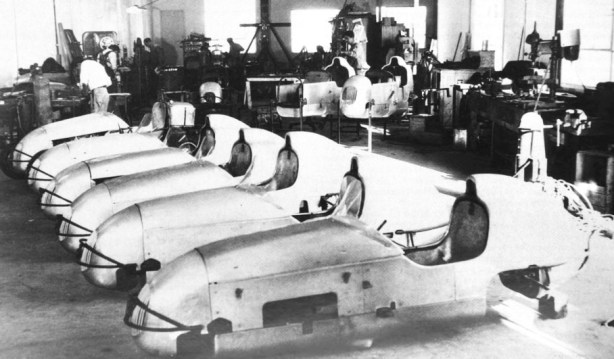
Undated shot of a staged Kurtis Midget production line, for a time he was building a car a day! Kurtis built more of the things than any other manufacturer (Frank Curtis Collection)
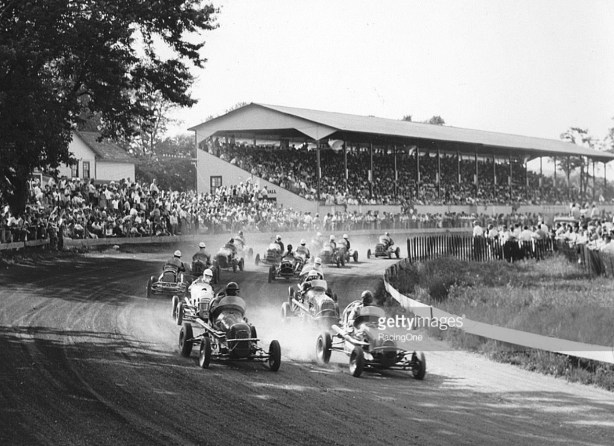
Huge field of Midgets on lap one of a race at Mineola Fairgrounds, Nassau County, New York on 23 August 1948. This venue used from 1925 to 1949 (Racing One)
Frank Kurtis, a native of Crested Butte, Colorado was born on January 25, 1908. He moved with his Croatian born family – his real name was Kuretich – he was one of eight children, to Los Angeles in 1922. He began building cars as a youngster at his father’s blacksmith shop in Pueblo, Colorado which repaired cars and horse-drawn buggies. It was Frank’s talented father who instilled precision craftsmanship into the youths psychy.
His first car was a T-Model Ford to which he added a special body. In the early 1920’s Kurtis began his car making apprenticeship with Don Lee Coach and Body Works, the local Cadillac dealer, broadcaster and racer nut who built custom cars for Hollywood stars. Father and son both worked at Lee’s, Frank improved his welding and metal shaping skills building some quite exotic car bodies.

The beautiful rail-frame midget on the right, known as the Jewel Box was built by Kurtis for Charlie Allen and driven, and later by owned, Roy Sherman. The guy between the two frame-rail midgets being built is Kurtis’ Ted Halibrand, later famous for his alloy wheels (unattributed)
Kurtis’ first work on a racing car seems to be the construction of a one-off radiator shell for a roadster run at Jeffries Ranch, a half-mile dirt track at Burbank, California. Work on the Atlas Chrome Special and Stagger Valve Fronty Ford followed.
Frank’s first complete Midget was built for Tommy Lee, Don’s son in 1936. A succession of cars followed including the Jewel Box Offy and other Midgets for Charley Allen, Lou Fageol, Rex Mays, Bob Swanson, Roy Sherman, Ted Halibrand and others.
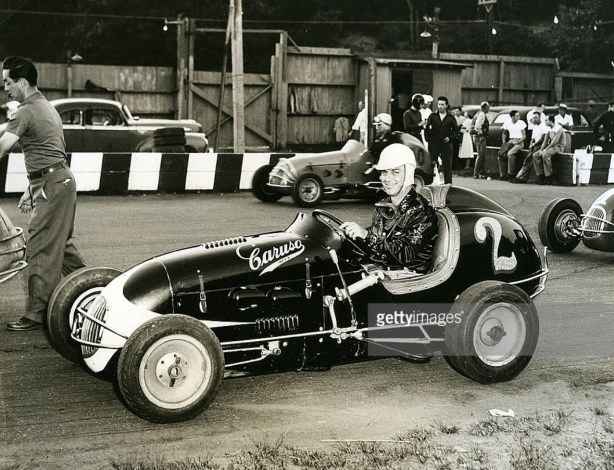
Bill Schindler’s Mike Caruso owned Kurtis Black Deuce Offy won 53 races in 1947 and 1948, taking the American Drivers Club title in 1948. Kurtis set a styling trend which continued for decades if not today (Racing One)
Post war, by 1946, he was building an assembly line of Offy engined midgets. Watching pre-war midgets bucking and bouncing through the turns, he thought their centre of gravity was too high and suspensions too stiff, his racers points of difference addressed these ills.
Frank’s chassis were stiff spaceframes made of ‘4130’ chrome-moly tube rather than the sheet steel rail-frames of his earlier cars and those of most of the competition. The suspension used torsion bars which reduced unsprung weight and allowed better road holding. He used Dzus fasteners which allowed the body to be removed in minutes, which meant the Offy could be serviced more quickly between events. The cars were lower and more softly sprung which made his chassis easier to handle and gave superior traction so the powerful Offy’s could put all their horses to the dirt. He built hundreds of them.
The Midget craze was dying by 1948, race fans were losing interest in the smaller cars, being attracted by bigger Champ Cars and Kurtis was there to service that market…

Walt Faulkner in his JC Agajanian Grant Piston Rings 1948 Kurtis 2000 Offy 220 at the California State Fairgrounds on 15 October 1950. He is contesting an AAA Sprint/Champcar race, note the difference in size compared with the various Midget photos (Racing One)

Johnny Parson’s Kurtis Offy 270 1950 Indy winning chassis. The car had no type designation but was built in 1948/9 and called Kurtis Kraft Spl . Parsons was second the year before in the same car (unattributed)
In 1949 a Kurtis-Kraft dirt car won the AAA title, in 1950 the same chassis driven by Johnny Parsons – the Wynns Oil Spl – won the Indy 500.
In this period Frank built a one of a kind Buick and a production sportscar which was later to become the Muntz Road jet in 1950. More of the sportscars later in the article.
The 1951 Indy 500 was won by a stretched-midget built from Kurtis parts supplied to Meyer Drake, the Offy engine manufacturers.
It was allocated chassis # 327-49. Originally powered by an experimental centrifugal-supercharged Offy Midget engine with a capacity of 106.81cid, weighing 280 pounds. So fast was the car, that their customers complained about unfair competition, so Meyer Drake sold it to Murrell Belanger.
It won the 1951 500 in Lee Wallard’s hands with a slightly-undersized 241cid Offy. The engine was a combination 270 block and 220 crank which they managed to squeeze into the chassis designed for the much smaller 107cid blown Midget engine.

1951 Indy front row; Jack McGrath KK 3000 Offy, winner #99 Lee Wallard K Offy and#18 Duke Nalon Kurtis Novi V8 (unattributed)
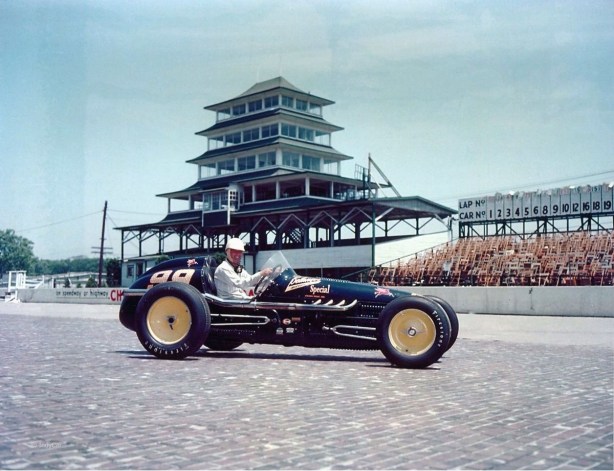
Lee Wallard Kurtis Offy 241 1951 winner. Stretched-Midget built by Meyer Drake from Kurtis parts (unattributed)

Popular Mechanics May 1952 article about the upcoming Indy 500, pic shows the low build of the Kurtis 1952 roadsters
In 1952 Kurtis built three pioneering roadsters (500 Series) with elongated wheelbases and lowered bodywork and centre of gravity.
Popular Mechanics reported that the cars weighed 1500 pounds, the frames were of chrome moly elliptical section tube plus a nine inch deep aluminium sheet box that also served as part of the skin. To save weight, the cowl and firewall were designed as structural parts of the frame. The front suspension system comprised two torsion bars mounted in a crisscross fashion instead of parallel to the frame.
Joe Scalzo, “They showed up at the speedway looking like freaks among all the high bodied dirt track cars and antediluvian front-wheel drives.”
The cars fates varied. The Cummins Diesel was out early with a broken supercharger but its huge, tall 401cid straight-six, with the engine laid on its side, plonked it on pole despite weighing 2150 pounds dry. In so doing Frank Kurtis built the first laydown-chassis Indycar.
The Auto Shippers, an upright roadster (type 500A) didn’t start, but oilman Howard Brighton Keck’s Offy 270 powered Fuel Injection Spl’\ driven by national midget champion, Bill Vukovich, dominated the race before a steering pin failure resulted in a kiss of the wall with 20 miles to run.
Vukovich won in the Kurtis 500A ‘Fuel Injection Spl’ in 1953/4.
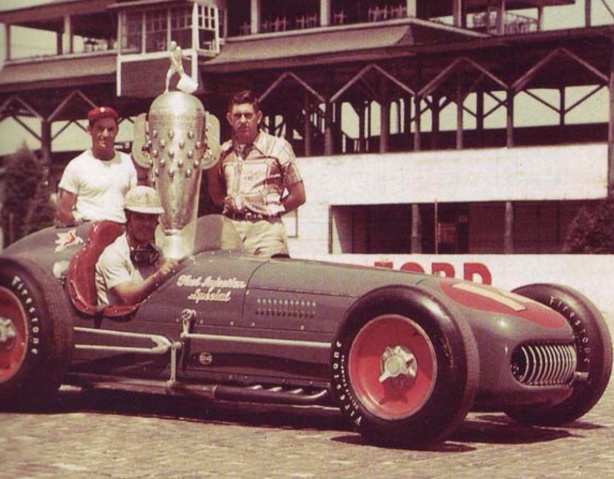
Vukovich, Jim Travers and Frank Coon after their 1953 500 win, Kurtis Kraft 500A Offy 270. The Offy 270 gave circa 345bhp @ 5500rpm in 1952 on methanol. Fuel rules at Indy were not strictly enforced then, a dose of ‘pop’ – nitro-methane – in qualifying for four or so laps was good for another 40bhp! (unattributed)
Scalzo related the changes needed to make the car competitive. “Arriving…late for its debut, it was immediately hailed a disaster by Howard Keck’s longtime mechanics Jim Travers and Frank Coon…the ‘Toonerville Trolley’ had torsion bars behind the rear axle and in front of the front axle and the anchor points were wrong. It had a vertical steering shaft holding the two steering arms together and its steering geometry was off…the track surface made the out of balance Fuel Inj Spl a flexing spastic. Travers and Coon rescued it with remedial repairs…Jim and Frank were rich in racing savvy and were veterans of weekly Midget brawls at Gilmore Stadium and Culver City Speedway, they were used to tricking out Keck’s stable of 110cid Offys.”
“To overcome the flaws of the Fuel Inj Spl they fell back on old speedway racing habits. Among other things they ‘jacked-weight’ across its rear end, and by deliberately misaligning its 270cid Meyer-Drake by one-bolt and 36-degrees to the bell-housing, wedged hundreds of static pounds to the FI Spl’s left…All this worked like a charm…Additionally, they and colleague Stu Hilborn had a reputation for…making Offy horsepower,” Scalzo said.
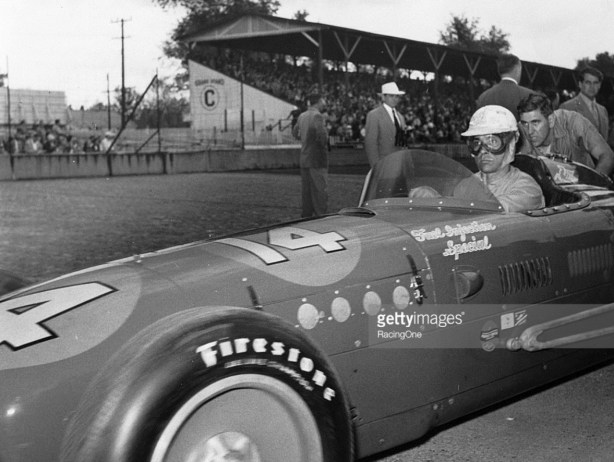
Vukovich sets off after a pitstop in his victorious Kurtis 500A Offy 1953 run. He won in 1954 but died in the ’55 500 in an accident not of his making (Racing One)
Kurtis cars won the 500 in 1953, 1954 and 1955. For the next eight seasons through to 1963, when Kurtis made his ‘model 500L for lemon-Scalzo’, (the bulbous American Rubber 73 missed the cut) upwards of 60 KK’s raced at Indianapolis. Production numbers of the cars appears as follows; 11 in ’53, 10 in ’54, 6 in ’55, 5 in ’56, 16 in ’57 and 7 between 1958 and 1962.
Scalzo, “The end of Frank Kurtis was sad. A disgruntled and embittered FK turned into an awful grouch pigeonholing Kuzma, Epperly, Lesovsky and especially AJ Watson as thieves who stole all his roadster ideas and became heroes at his expense.”
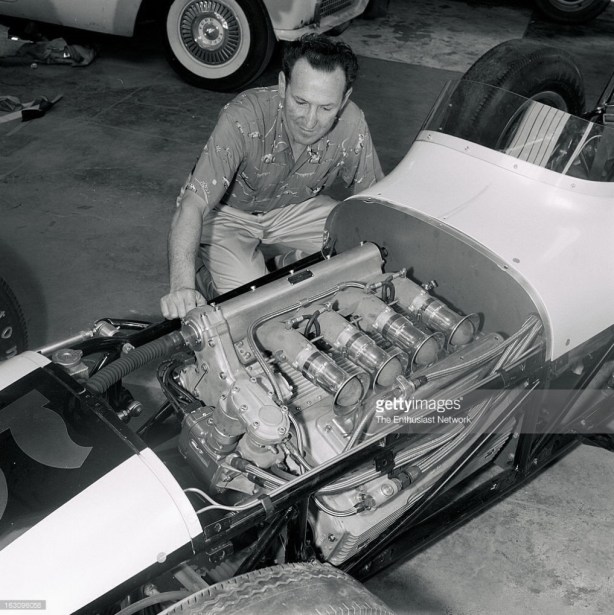
George Bignotti beside his 1960 Indy entry, the Kurtis Seal Fast Spl driven by AJ Foyt, DNF clutch. The ultimate expressions of the roadster trend started by Kurtis were full-lay-downs built by Salih, Epperly, Kurtis and others. Also Watson’s ‘offsets’ built with ‘short-tower’ lower block Offys than the 270’s taken back to 255cid used by others; the regs demanded a 4.2-litre unsupercharged limit from 1957. This car was built as a Kurtis, but for 1960 had an Epperly chassis, body and front end. Offy engine a 255 cid four cylinder, five bearing, monobloc, DOHC four valve, Hilborn injected unit giving circa 350/360bhp @ 6200rpm on methanol, weight 452lbs (The Enthusiast Network)
Frank Kurtis’ Indy track record is to be envied in the extreme. His Offy powered cars sat on the Indy pole eight times, he won five times; in 1950 (Parsons), 1951 (Wallard), 1953/4 (Vukovich,) and 1955 (Sweikert). His cars were also fourth in 1947, third in 1948 and second in 1949 and 1952. Fifteen of the top 20 cars at Indy in 1953 were Kurtis chassis!
The last Kurtis chassis victory in a National Championship event was Van Johnson’s victory at Langhorne on June 14, 1959 in Kurtis Kraft 4000 chassis #368-53.
One of the most famous and bizarre Kurtis appearances was Rodger Ward’s entry of a Kurtis Offy Midget in the inaugural F1 US Grand Prix at Sebring in 1959…
Promoter Alec Ullman was chasing bums-on-seats, the entry of Ward, the 1959 Indy champ made commercial sense. Ward had had some road racing success, racing his Midget against sports cars, notably at a Lime Rock meeting during a Formula Libre race.

Rodger Ward’s Kurtis Offy Midget chasing, and soon passing George Constantine’s Aston Martin DBR2 at Lime Rock, a twisty ‘right hand’ road course on 25 July 1959. Ward beat some of the best sports racers in the country in this F Libre race (Offenhauser)
For the Grand Prix though, his two-speed gearbox, two-speed rear axle, hand braked, supercharged 1.7-litre Offy was at a severe disadvantage to the other front engined F1 cars, let alone the revolutionary Coopers. The Kurtis was chassis #O-10-46, yes folks it was built in 1946! The car raced on 12-inch wheels and Firestone slicks pre-dating their reappearance in F1 in 1971!
Ward qualified last and DNF with clutch failure after 20 laps in the race won by Bruce McLaren’s Cooper T51 Climax after Jack Brabham ran out of fuel on the last lap. His fourth place, pushing the Cooper over the line, gave him the title.

Rodger Ward contesting the 1959 USGP at Sebring in his supercharged Kurtis Offy Midget. He won the Indy 500 that year in a Watson Offy 255 Roadster (Louis Galanos)
While the focus of this article is the Indy cars, Kurtis also built some fantastic sports cars…
In 1949 he built the Kurtis Sports Car which featured on the cover of the very first Motor Trend magazine in October 1949. Kit prices started at $1495, inflation drove costs up so much that only 17 kits were sold, Kurtis sold the rights to Earl Muntz in the early 1950’s. Almost 400 of these steel bodied, Caddy/Lincoln engined Muntz Jet’s were built.
In 1953 Kurtis built the 500S, the chassis and suspension of which took its cues from the 500A Indy Roadster. The chassis was a ladder-frame, drilled for lightness, the solid front axle was tubular suspended by trailing arms and torsion bars. A live axle was also used at the rear, again suspended by torsion bars.
The 500S could be supplied as a kit or complete ex-factory, the body was aluminium, and with cycle-guards was aggressively handsome. The complete car sold for $4986 less engine and ‘box. It’s estimated that 30 500S cars/kits were sold from 1953-5.
Bill Stroppe’s short-wheelbase, 282cid ‘flathead’ Mercury V8 powered car was the most successful racer, achieving many wins in 1953/4.
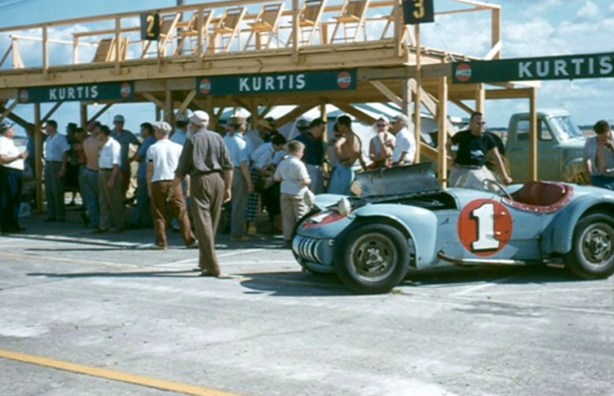
Kurtis 500S, 1955 Sebring 12 Hour. The Jack Emsley/Jim Rathman car was out on lap three with Cadillac engine failure. The race was won by the Hawthorn/Phil Walters Jag D-Type (unattributed)
The 500X followed, it was an evolution of the earlier car but with a much nicer spacefame chassis. Although live-axle suspension remained, the rear axle incorporated a Halibrand quick-change unit. Between six and 12 were built (quite a range!) the cars were clothed in a very attractive aluminium body.
The 500M was designed for smaller engines, used a fibreglass body, and the Kurtis 500KK kit chassis pictured below, 18-20 cars were built.
In the early 1960’s Kurtis laid down three machines which were essentially widened Indy Roadster chassis. One of these, Jack Lufkin’s 1964 Bonneville Streamliner, was the fastest Kurtis ever, topping 245mph in 1968. Several other racers were built, including a ’62 Bonneville A-Model pickup, a pair of dragsters and a Saab powered H-Modifed car also in 1962.
Kurtis designed and built the start-carts for the Lockheed Corporations SR71 Blackbird, a project which continued into the 1980’s.
Frank Kurtis retired in 1968, but his son Arlen continued the business which diversified into high performance drag racing and water skiing. In more recent times he has built “limited productions of a few models of cars and parts his dad once built.”
Etcetera…
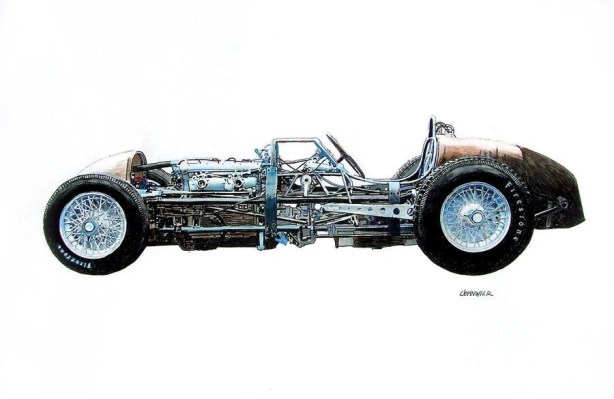
The factory Kurtis Kraft ‘1000’ Offy’, 1948 Series Champcar. Powered by ‘270’ Offy. Cutaway from a photo original (John Wickhart)
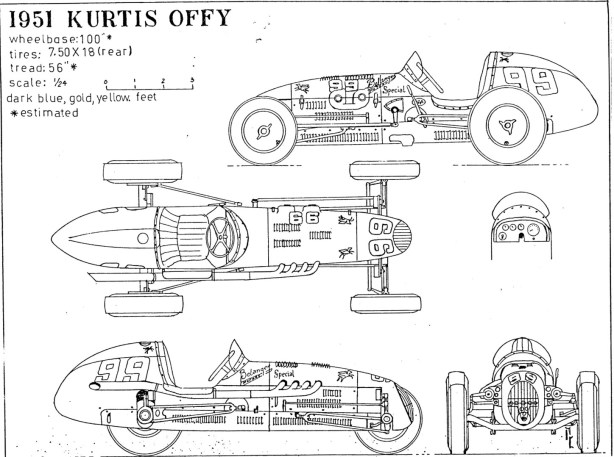
The 1951 Meyer Drake built stretched-midget built from Kurtis parts is sometimes allocated chassis # ‘327-49’ . Won ’51 Indy fitted with Offy ‘241’ cid engine (unattributed)
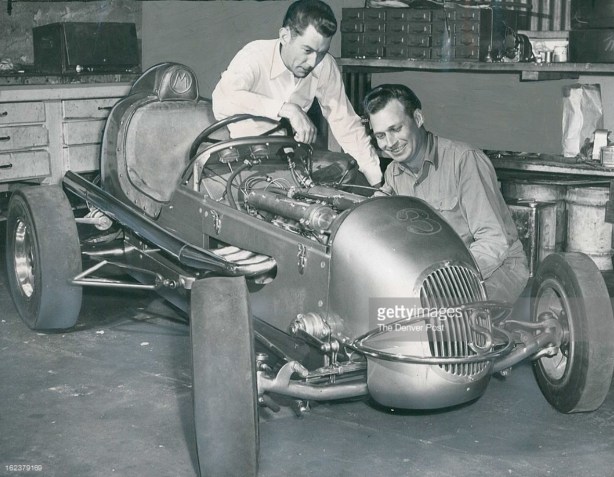
I love this shot as it gives great human-scale to these Midgets and 91 or 110cid Offys. The Kurtis was raced by Don Lowe at left, fettling the car with owner Miles Spickler on June 2, 1949. The upcoming meeting is at Lakeside Speedway, Denver. Offy Midget engines were 100/102 and 110cid in the 1960’s. Iron block, aluminium crankcase, three bearing monobloc – the block and head one unit – DOHC, two-valve, circa 237lbs in weight. Post-war they were fitted with two 1.5 inch Riley carbs and later, Hilborn continuous fuel injection. By 1947 the engine produced 120bhp @ 6000rpm on alcohol and in 1950 injected form 143bhp @ 8000rpm on alcohol (The Denver Post)
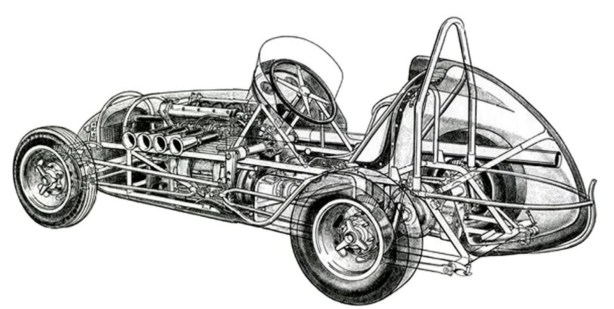
Kurtis Kraft Offy Speedcar, not sure of date or model. Hilborn injected 110cid engine (David Kimble)
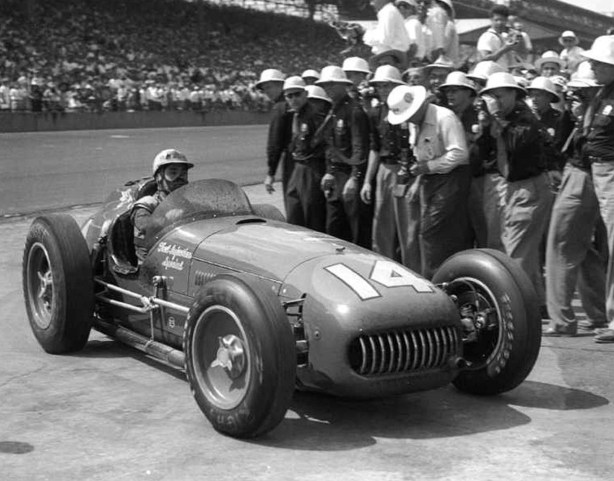
Vukovich, Kurtis Kraft 500A Offy 270, 1954 Indy winner. Vukovich used the same chassis #353-52 in his 1952-54 races (unattributed)

Leo Goossen’s factory drawing of the Offy 270 which was the supreme engine in championship racing from 1947-56. This is a later injected version. When the capacity limit was reduced to 4.2-litres the engine capacity was reduced from 274 to 255cid, Meyer Drake simply reduced the internal dimensions of the engine a smidge (Leo Goossens)
Bibliography…
Joe Scalzo ‘Indianapolis Roadsters 1952-64’, Popular Mechanics May 1952, Don Capps on The Nostalgia Forum, Gordon Eliot White ‘Offenhauser’
Photo Credits…
The Enthusiast Network, Racing One, David Kimble, John Wickhart, Frank Kurtis Collection, Louis Galanos, Max Staub
Tailpiece…





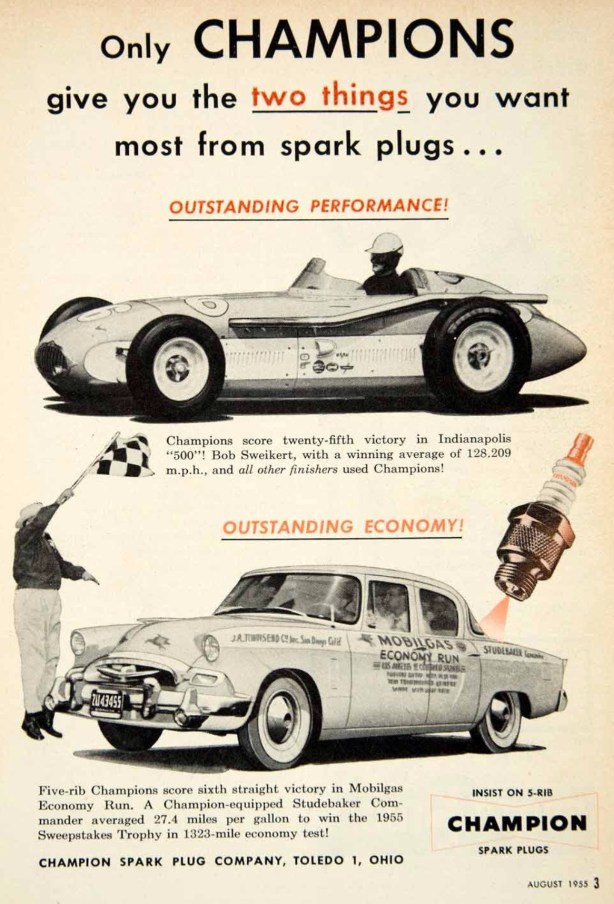
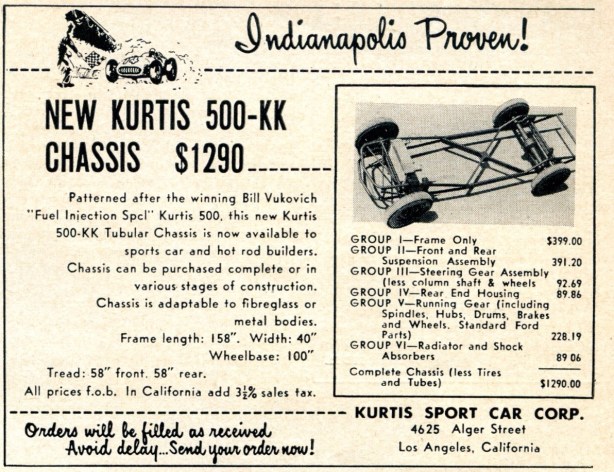




Fantastic Article!
Fascinating topics aren’t they Spyder! Not ones I knew much about, if you are into these cars the two books by Gordon Eliot White are the go, on Kurtis and Offenhauser, I don’t have either but have been lent the Offy book which is just fantastic, am churning my way thru it at the moment, mark
It would be fascinating they both have such rich history!
The mention of Rodger Ward driving his speedway midget in the 1959 United States Grand Prix reminds me that back in 1940, visiting American speedway driver Paul Swedberg drove his Offy-powered speedcar at the Easter 1940 meeting at Mt Panorama – he was a very brave man!
Kurtis Kraft Offy powerd what a era in Aust 60&70s
Thanks to Frank Kurtis.🏁🏁🏁